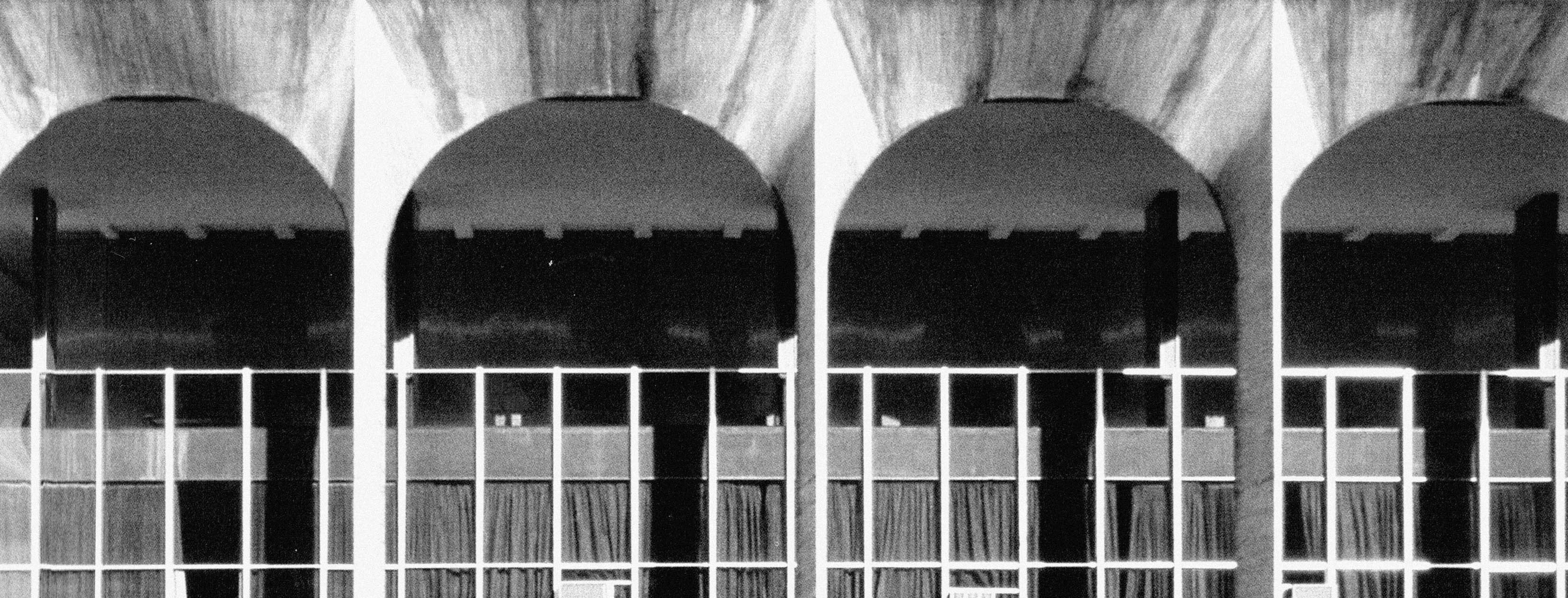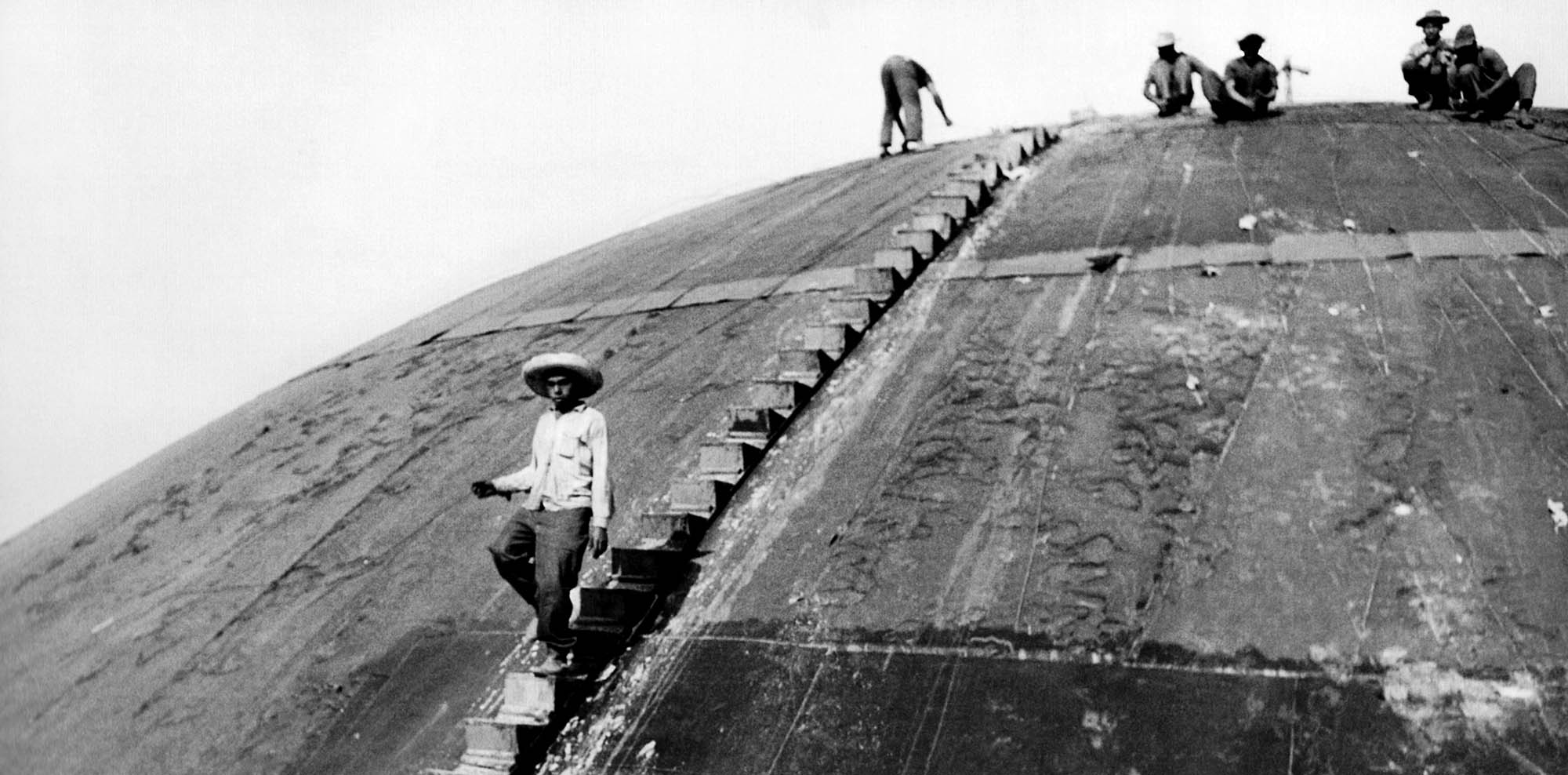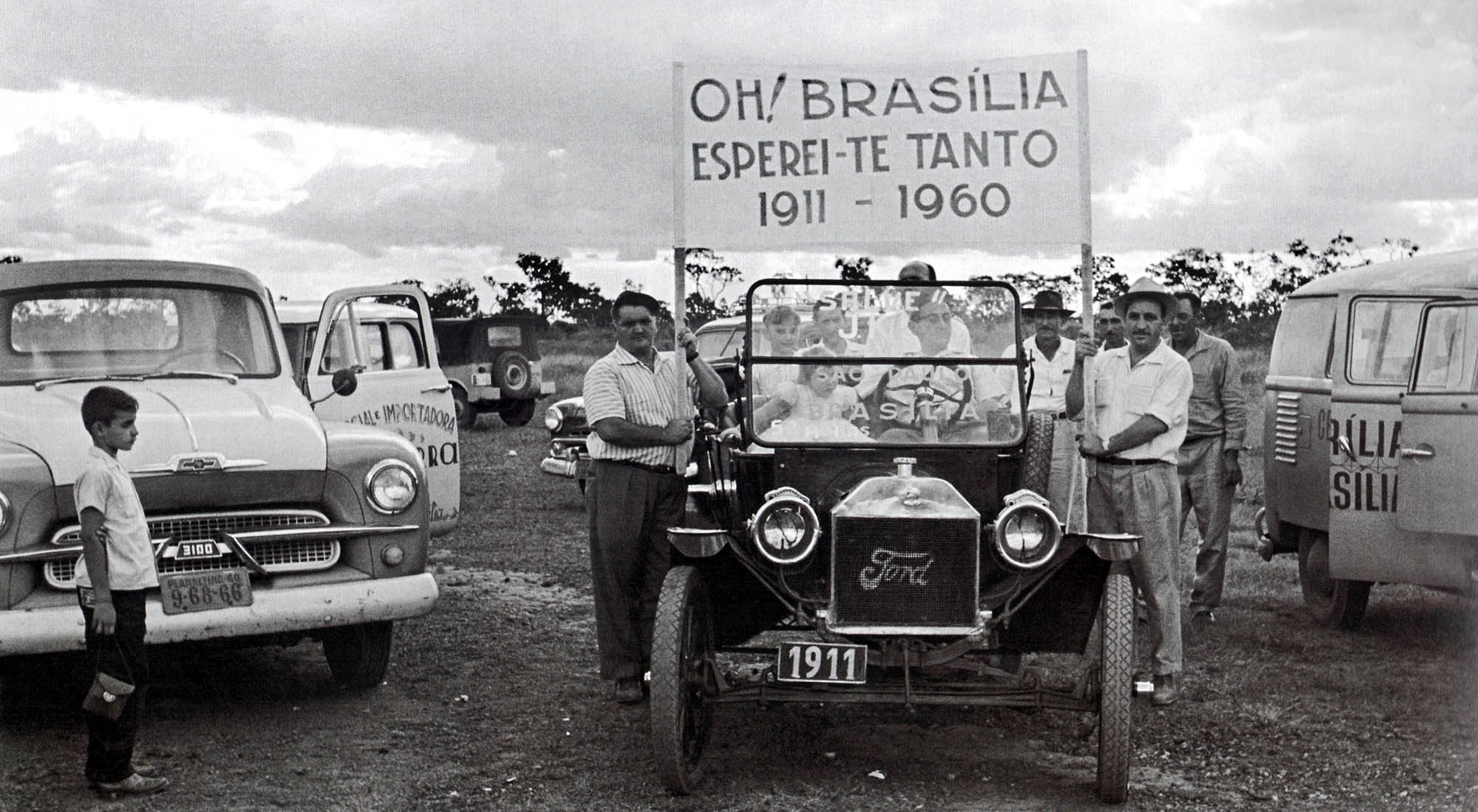
BRASÍLIA by REM KOOLHAAS
Dutch architect writes about the Brazilian modern city
TEXT REM KOOLHAAS
TRANSLATION BRAM VAN DER HOUT
REVISION & EDITION GABRIEL KOGAN & RODRIGO VILLELA
[Editor’s Note: This was written by Rem Koolhaas on the occasion of his first trip to Brasília in August of 2011, and has since remained unpublished. Revista Centro (online Brazilian magazine about architecture, urban studies, art & social science) brings it now in two versions (English and Portuguese) translated directly from its original language, Dutch. In addition to offering his first impressions about the modern Brazilian capital, Rem also emphasizes an autobiographical narrative about the origins of his relation with architecture]
Brasília
In 1956 – I don’t remember the exact circumstances – I happened to come upon an article in TIME Magazine about the new Brasília. The article unveiled the plans for a city-to-be, right in the centre of the country; a dream of a city that would soon become a reality. It was there and then that my 11-year-old self made a decision: I was to become an architect. And not just any architect – a Brazilian architect.
What followed were years of sketching and planning – emigration plans in particular; a rather ambitious project for a grammar-school student. Practicality caught up with me, and for eight years I managed to ignore the Brazilian pull. I became a journalist, and a co-writer of movie scripts. Until the day I realised – and this was nothing less than a revelation to me – that an architect is the one who decides the scripts of daily life. My initial calling rang more clearly in my ears than ever before.
A lot had happened between 1956 – the year TIME published its article – and 1968. By this time I was studying architecture in London. My conviction that architecture is a creative power, one that has led humanity for over three thousand years, was undermined by doubt and flower power. I became an architect at a moment in time when the foundations of architecture itself seemed about to crumble.

1968
‘Generation 1968’ was the generation that would set mankind free – free from architecture, amongst other things. The city as a modernist ‘ideal’ was no longer conceivable, nor relevant. ‘Order’ was a dirty word, and had been replaced by ‘self-organisation’. Utopias had turned into grim fairytales, used to ward off the incurable idealism of architecture.
I personally did not join in this collective abdication. On the contrary: I studied the Berlin Wall, the construction of which was finished in the same year as Brasília, to prove the continuing power of architecture – the power to cut cities and lives in two. This was an argument that didn’t seem to convince anyone at the time…
Now, almost half a century later, I am in Brasília, the first city that made me want to build cities myself. Between 1972 and today, I have passionately researched and written about world cities: New York, Atlanta, Lagos, Singapore, China’s Pearl River Delta, even Dubai. Not as ideal cities, but as cities that exhibit uncontrollable qualities. I have looked at those cities through the eyes of an anthropologist, rather than from a moralist’s perspective. As an architect, I should have rejected them altogether.
Today, however, the city itself is not my main preoccupation anymore. We all know that the world is urbanising at break-neck speed. The classical city no longer exists; in its stead, cities with 30 million inhabitants will become the norm during this century. People are leaving the countryside in ever-growing numbers; I look at what those last inhabitants have left behind. The countryside, the unknown frontier of change… Brasília, then, would be the last city.
2011
Brasília’s design has the shape of an airplane with its wings pointing forward. The plane’s fuselage consists of two rows of five identical ten-story buildings: one for each Ministry. The rows are separated by a wide strip of green: the corridor.
The parliament is located in its tail: two raised disks and a platform upon which a dome – the Senate – and a flying saucer – the House of Representatives – have landed.
At the moment of my visit, the wide strip of green has been turned into a sea of red flags and banners, held by peasants who are singing and shouting in protest against a corrupt and arbitrary ruling class.
Inside the parliament building, another group of farmers, just as numerous as the ones outside but clad in green, are being ushered in under the glorious banner of microcredit.
The wings of the city layout consist of over 130 so-called “superblocks” (superquadras): rectangular plots of land with an average of nine orthogonally-placed apartment blocks each, all different yet monotonous– a city of 1,500 apartment blocks in total.
Sartre has been here to take a look, as well as Queen Elizabeth, Fidel Castro, Che Guevara, and Willem Sandberg. André Malraux saw the city as a sign of hope; the Pope gave his blessing, as did most modern architects: Gropius, Le Corbusier, Prouvé, Mies van der Rohe, Nervi.
Juscelino Kubitschek, Brazil’s president between 1956 and 1960, conceived Brasília as a military campaign. The ‘airplane’ was designed by Lucio Costa in 15 days, using paper and ink. The fuselage was exclusively furbished – in only four years – with buildings by Oscar Niemeyer. Niemeyer, afraid of flying himself, travelled between the old capital, Rio de Janeiro, and the new administrative centre in a Land Rover. Brasília contains an exceptional number of buildings, produced by one architect, at an insane speed.
His haste and urgency are still palpable. No nonsense, nothing superfluous, no unnecessary details. Niemeyer had no choice and this may be why he is considered a genius to this very day.

Oneliner
The word ‘oneliner’ often has negative connotations. In architecture, however, a sketch consisting of one flowing line is considered proof of genius. Those oneliners remain Niemeyer’s strength – or are they his handicap?
In Brasília, there are two buildings that fascinate because they’re each other’s opposites. The one is a merciless, slightly bent, 700 meter-long line. This is the university (UNB). All aspects of learning and research are brilliantly summed up in this seemingly endless, prefabricated concrete serpent.
Its absolute opposite is the Ministry of Foreign Affairs. A neutral, nondescript block on the outside, its inside turns out to be a boîte à miracles, hollowed out as a labyrinth. A palace of diplomacy, consisting entirely of sensations – from challengingly abstract to overpoweringly decorative. A mise-en-scène for the pure sake of effect.
Niemeyer had his ghostwriters for these kinds of stunts: the concepts and sequences of the interior were orchestrated by ambassador Vladimir Murtinho, a born diplomat. Some of the rooms are too beautiful for their often shady visitors; and this is all intentional.
Compared to Niemeyer’s, almost all other architecture seems sombre and unnecessarily laboursome. The weather plays a part in this. Brasília is located on a savannah-like plateau. It is an outdoor city: everything one would do indoors elsewhere can be done outdoors in Brasília, all year long. The architecture is unencumbered by the tasks assigned to it in the North – preserving warmth – or in the South – cooling down. A paper-thin membrane, a single pane of glass, suffices to mark the boundary between indoors and outdoors.

Costa’s ‘plane’ touched ground in the exact centre of the country. This is for political reasons. The idea was to shift the focus from Brazil’s overpopulated coast to its unexplored interior. The success of this project is shown, paradoxically, by the fact that this most recent example of intensive master planning – intended for 500,000 inhabitants – is now surrounded by a shapeless blob of a city with 3.5 million inhabitants, grown into being according to the laws of the market economy.
The exemplary ‘airplane’ has become no more than a neighbourhood, embedded in a much larger and generic city. As a result, the first impression when looking at this layout is not its authoritarian character, but the vulnerability of modern architecture…
The gargantuan political power employed to make Brasília possible has succumbed to the even greater force of the market tsunami. The market, a growing force since the 80s, makes quick work of fragile political statements such as Brasília. No matter how authoritarian the old Brasília may look when seen from the sky, the market regime will always come out on top, more authoritarian even in its randomness.
Does this matter? No. We must simply conclude that the essence of Brasília does not consist of its architecture, but of the decision to move Brazil’s government inland.
Brasília is not a disappointment, but neither is it a baffling reencounter with an old, singular ideal. It’s a final spasm rather than a new dawn. A confirmation that this ideal has lost its credibility for the time to come…
The rigid organisation of the city has had unpredictable results: Brasília has become a record-holder in insanity, divorce, and fatal traffic accidents (perfect roads, bad drivers, no speed limit). As all diplomats were housed in one and the same apartment block, those concrete towers became the birth ground of the punk movement in Brazil in the 80s: a high concentration of international teenagers with the right kind of music tapes.
The clear structure of the city made it relatively easy for the military junta to take over the city in 1964: Brasília became an orthogonal panopticon – a singular utopia as a substratum for dictatorship.
Heritage
The wings of Brasília’s plane layout remain unfinished, but the whole project was put on the UNESCO World Heritage List in 1987 anyway. What started fifty years ago as the prototype of a new era has now become a relic of the past. The design is highly relevant today, fascinating even, albeit for very different reasons: how do you ‘preserve’ that which is modern, or in other words, how do you stop modernity in its tracks?
The lobbying work for Brasília’s status as a World Heritage Site started immediately after the first portion was delivered, headed by president Kubitschek himself. This makes him a two-fold visionary: not only did he build the new capital, he also managed to have this feat recorded for posterity by UNESCO. But how can modernity be held on to? According to UNESCO, the fuselage and the wings of Brasília’s layout must be preserved forever. The apartments are now home to the city’s wealthiest inhabitants – the price per square meter is higher than anywhere else in the city, perhaps because of its World Heritage status.
Bizarrely, the language and typology of modernism have turned out to be untenable in the areas for which it was originally intended. In Europe, social housing blocks are being demolished at breakneck speed – yet they flourish in climates and cultures where they don’t seem to belong: Zanzibar, Singapore, Rio. The 130 blocks in Brasília have become a refreshing collage of hardcore 60s socialism and neoliberal comfort zones. A unique amalgam of seemingly incompatible elements.
Greek temples, three thousand neglectful years after being built, are still standing. They are easy to preserve. A 2,000-year-old villa in Pompeii is still quite inhabitable, and a home built by Palladio is still bursting with palpable intelligence, five centuries hence.
The Rietveld Schröder House, on the other hand, is less than a century old, yet it looks more precarious and less ‘alive’ than its much older counterparts. Modernity is fundamentally ephemeral; it was never meant to last the ages. Modern architecture is, at best, a minimal membrane separating part of a space in order to make it temporarily useful for a specific purpose. The aesthetics of modernity is a constellation of nuances, each meant to be transient.
UNESCO often threatens to strip a site of its status when it or its surroundings are becoming too drastically or too visibly modern. Dresden lost its status because of a new bridge that was thought to threaten the beauty of its protected riverbank landscape. Saint Petersburg is at risk of losing it because of the construction of a Gazprom tower.
Tiring of these endless frontline battles, UNESCO is developing a new definition of the Historic Urban Landscape: heritage is no longer considered as a single object or a single urban ensemble, but as ‘all natural and historical layers of a site, its empty spaces, its infrastructure, and its social, cultural, and economic processes’. Brasília might be one of the most interesting tests for this new definition.
In CRONOCAOS [1], we concluded that the interval between ‘now’ and that which has been ‘preserved’ is shrinking continuously. Shortly, heritage might even acquire a prospective character instead of a retrospective one.
In Brasília, this is already happening. A federal ukase from 1992 demands that any addition to the ‘plane’ be designed by Niemeyer himself (at that time, 85 years old). From this moment, Niemeyer’s future plans were automatically considered World Heritage. And this might make him the biggest threat to his own posthumous reputation: Niemeyer’s most recent additions are nonchalant, sometimes grim, seldom convincing, and always situated somewhere in the wide range between the sublime and the worthless. Just as the ‘older De Kooning’, his recent work makes one wonder whether there still is a functioning mind guiding the master’s hand, or whether the hand has taken over.

UFO
Concluding, I have to admit I am curious about the ‘wrong’ Brasília. As it turns out, this epicentre of modernity – a former minister called it the ‘Capital in the Age of Aquarius’ – allows room for bureaucracy as well as the largest concentration of sects and mystics.
The largest sect, Vale Do Amanhecer, was founded by Tia Neiva, a female truck driver who was one of the city’s first pioneers. Nowhere on the planet, the sect claims, is the Earth’s crust thinner – and therefore the distance between the surface and the Earth’s molten core shorter – than here in Brasília. An excellent attraction, not only for credulous earthlings, but also for flying saucers which, hovering over a lake, charge themselves with the globe’s energy and might decide to land upon the water.
The sect’s headquarters looks like an ultra-serious playground, a labyrinth of slight curves that were drawn onto the ground by the founders themselves – and which doesn’t differ too much from Niemeyer’s recent work. At sunset, adepts in Star Trek costumes join in the UFO ballet.
And I find myself secretly wishing I could believe in either architecture or flying saucers.
END
REM KOOLHAAS,
Dutch architect; Pritzker Architecture Prize Laureate (2000); co-founder and partner of OMA
NOTES:
[1] The ‘preservation’ of Brasília touches upon my current interest in heritage, which, amongst other publications, was put into words in CRONOCAOS, a heritage manifesto for last year’s Biennale in Venice.
CRONOCAOS is about the astounding portion of the planet today that is, in one way or another, subject to ‘preservation’, the safeguarding and protection of cultural and natural heritage. According to our most scrupulous count, this concerns twelve percent of the Earth’s surface today. The world has not given enough thought to this new and growing circumstance: in the future, half the world will have to change radically in order to meet the new demands of life on this planet, whereas the other half will be unavoidably stuck in the past. A stagnation of which Amsterdam’s ring of canals is now part as well, since its surprisingly unnoticed recognition by UNESCO.
©Revista Centro/2016. Any reproduction, representation, in whole or in part, use, adaptation, provision or modification by any process, any person and any means whatsoever (particularly sales, marketing, rental, etc.) of this translation without the express authorization of Revista Centro, any authors, translators, editors or rightholders is strictly prohibited and constitutes a violation.

